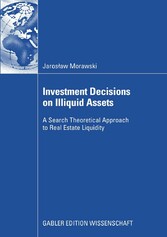Suchen und Finden
Service
Investment Decisions on Illiquid Assets - A Search Theoretical Approach to Real Estate Liquidity
Jaroslaw Morawski
Verlag Gabler Verlag, 2009
ISBN 9783834999559 , 438 Seiten
Format PDF, OL
Kopierschutz Wasserzeichen
Chapter 5 Liquidity of German Condominium Markets (S. 307-309)
A number of techniques for dealing with low levels of liquidity of privately traded assets, in particular real estate, have been developed in the previous chapters. They are based on the model of search for a trading partner, which allows a formal analysis of the selling or purchasing process and the resulting net receipts or expenses. Large parts of the discussion focused on the derivation of closed form solutions that could be applied in practice using data available to investors. However, most of the hitherto considerations were only theoretical. It is possible, and even probable, that in the course of their practical application to concrete problems obstacles occur that have not yet been addressed.
This Chapter is intended to uncover and discuss some of such obstacles and to demonstrate possible ways of dealing with them. This is done by applying the search theoretical methodology to analyze liquidity of residential condominiums in selected German urban areas. This exemplary application should be viewed as a step toward the practical implementation of the concepts developed in this book. The main problem with the application of the search theoretical approach to real estate liquidity is the determination of the model parameters.
Although it is relatively easy to define variables such as the gdivergence of valuationsh or the gfrequency of offer arrivalsh on the abstract level, it may be extremely difficult to assign them concrete values when addressing a specific real estate market. This issue is discussed in the first section of the Chapter. Further sections demonstrate the implementation of the model on German residential real estate markets.
The data is presented in the second section . it consists mainly of large samples of transaction prices for residential condominiums in selected large German cities. The third section is devoted to the comparison of liquidity levels of the analyzed markets using different approaches from Chapter 3. The fourth section utilized the methods developed in Chapter 4 to derive optimal liquidation strategies as well as optimal portfolio decisions with respect to investments in the analyzed markets. Finally, the last section summarizes the main findings and offers a critical discussion of the methods.
5.1. Determination of Model Parameters
Since all liquidity measurement and liquidity management methods presented in this book are based on the search model, their application depends on the ability to determine the parameters of the underlying model. While some of them are relatively straightforward, other are not directly observable and need to be derived implicitly from the available data. The latter, by their nature, are always more or less approximate, what results in errors affecting the quality of the decisions made on the basis of the model. This problem is, however, immanent to any methods attempting to capture complex processes within simplified model structures.
The question is therefore not how to entirely eliminate errors arising from the imperfect estimation of the parameters but rather how to minimize these errors. Yet, due to the novelty of the search theoretical approach presented here, no special error-minimization techniques are available, and developing such techniques is beyond the scope of this work. The section deals therefore mainly with the mere ability to determine, at least roughly, the values of the required parameters. There are six parameters in the relative real estate search model that are required for the computation of marketability and liquidity risk measures.



